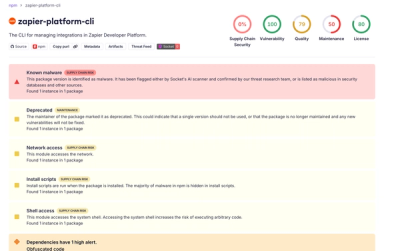@aws-sdk/client-elastic-load-balancing
Description
AWS SDK for JavaScript ElasticLoadBalancing Client for Node.js, Browser and React Native.
Elastic Load Balancing
A load balancer can distribute incoming traffic across your EC2 instances.
This enables you to increase the availability of your application. The load balancer
also monitors the health of its registered instances and ensures that it routes traffic
only to healthy instances. You configure your load balancer to accept incoming traffic
by specifying one or more listeners, which are configured with a protocol and port
number for connections from clients to the load balancer and a protocol and port number
for connections from the load balancer to the instances.
Elastic Load Balancing supports three types of load balancers: Application Load Balancers, Network Load Balancers,
and Classic Load Balancers. You can select a load balancer based on your application needs. For more
information, see the Elastic Load Balancing User Guide.
This reference covers the 2012-06-01 API, which supports Classic Load Balancers.
The 2015-12-01 API supports Application Load Balancers and Network Load Balancers.
To get started, create a load balancer with one or more listeners using CreateLoadBalancer.
Register your instances with the load balancer using RegisterInstancesWithLoadBalancer.
All Elastic Load Balancing operations are idempotent, which means
that they complete at most one time. If you repeat an operation, it succeeds with a 200 OK
response code.
Installing
To install this package, simply type add or install @aws-sdk/client-elastic-load-balancing
using your favorite package manager:
npm install @aws-sdk/client-elastic-load-balancingyarn add @aws-sdk/client-elastic-load-balancingpnpm add @aws-sdk/client-elastic-load-balancing
Getting Started
Import
The AWS SDK is modulized by clients and commands.
To send a request, you only need to import the ElasticLoadBalancingClient and
the commands you need, for example DescribeAccountLimitsCommand:
const { ElasticLoadBalancingClient, DescribeAccountLimitsCommand } = require("@aws-sdk/client-elastic-load-balancing");
import { ElasticLoadBalancingClient, DescribeAccountLimitsCommand } from "@aws-sdk/client-elastic-load-balancing";
Usage
To send a request, you:
- Initiate client with configuration (e.g. credentials, region).
- Initiate command with input parameters.
- Call
send operation on client with command object as input.
- If you are using a custom http handler, you may call
destroy() to close open connections.
const client = new ElasticLoadBalancingClient({ region: "REGION" });
const params = {
};
const command = new DescribeAccountLimitsCommand(params);
Async/await
We recommend using await
operator to wait for the promise returned by send operation as follows:
try {
const data = await client.send(command);
} catch (error) {
} finally {
}
Async-await is clean, concise, intuitive, easy to debug and has better error handling
as compared to using Promise chains or callbacks.
Promises
You can also use Promise chaining
to execute send operation.
client.send(command).then(
(data) => {
},
(error) => {
}
);
Promises can also be called using .catch() and .finally() as follows:
client
.send(command)
.then((data) => {
})
.catch((error) => {
})
.finally(() => {
});
Callbacks
We do not recommend using callbacks because of callback hell,
but they are supported by the send operation.
client.send(command, (err, data) => {
});
v2 compatible style
The client can also send requests using v2 compatible style.
However, it results in a bigger bundle size and may be dropped in next major version. More details in the blog post
on modular packages in AWS SDK for JavaScript
import * as AWS from "@aws-sdk/client-elastic-load-balancing";
const client = new AWS.ElasticLoadBalancing({ region: "REGION" });
try {
const data = await client.describeAccountLimits(params);
} catch (error) {
}
client
.describeAccountLimits(params)
.then((data) => {
})
.catch((error) => {
});
client.describeAccountLimits(params, (err, data) => {
});
Troubleshooting
When the service returns an exception, the error will include the exception information,
as well as response metadata (e.g. request id).
try {
const data = await client.send(command);
} catch (error) {
const { requestId, cfId, extendedRequestId } = error.$metadata;
console.log({ requestId, cfId, extendedRequestId });
}
Getting Help
Please use these community resources for getting help.
We use the GitHub issues for tracking bugs and feature requests, but have limited bandwidth to address them.
To test your universal JavaScript code in Node.js, browser and react-native environments,
visit our code samples repo.
Contributing
This client code is generated automatically. Any modifications will be overwritten the next time the @aws-sdk/client-elastic-load-balancing package is updated.
To contribute to client you can check our generate clients scripts.
License
This SDK is distributed under the
Apache License, Version 2.0,
see LICENSE for more information.
Client Commands (Operations List)
AddTags
Command API Reference / Input / Output
ApplySecurityGroupsToLoadBalancer
Command API Reference / Input / Output
AttachLoadBalancerToSubnets
Command API Reference / Input / Output
ConfigureHealthCheck
Command API Reference / Input / Output
CreateAppCookieStickinessPolicy
Command API Reference / Input / Output
CreateLBCookieStickinessPolicy
Command API Reference / Input / Output
CreateLoadBalancer
Command API Reference / Input / Output
CreateLoadBalancerListeners
Command API Reference / Input / Output
CreateLoadBalancerPolicy
Command API Reference / Input / Output
DeleteLoadBalancer
Command API Reference / Input / Output
DeleteLoadBalancerListeners
Command API Reference / Input / Output
DeleteLoadBalancerPolicy
Command API Reference / Input / Output
DeregisterInstancesFromLoadBalancer
Command API Reference / Input / Output
DescribeAccountLimits
Command API Reference / Input / Output
DescribeInstanceHealth
Command API Reference / Input / Output
DescribeLoadBalancerAttributes
Command API Reference / Input / Output
DescribeLoadBalancerPolicies
Command API Reference / Input / Output
DescribeLoadBalancerPolicyTypes
Command API Reference / Input / Output
DescribeLoadBalancers
Command API Reference / Input / Output
DescribeTags
Command API Reference / Input / Output
DetachLoadBalancerFromSubnets
Command API Reference / Input / Output
DisableAvailabilityZonesForLoadBalancer
Command API Reference / Input / Output
EnableAvailabilityZonesForLoadBalancer
Command API Reference / Input / Output
ModifyLoadBalancerAttributes
Command API Reference / Input / Output
RegisterInstancesWithLoadBalancer
Command API Reference / Input / Output
RemoveTags
Command API Reference / Input / Output
SetLoadBalancerListenerSSLCertificate
Command API Reference / Input / Output
SetLoadBalancerPoliciesForBackendServer
Command API Reference / Input / Output
SetLoadBalancerPoliciesOfListener
Command API Reference / Input / Output



